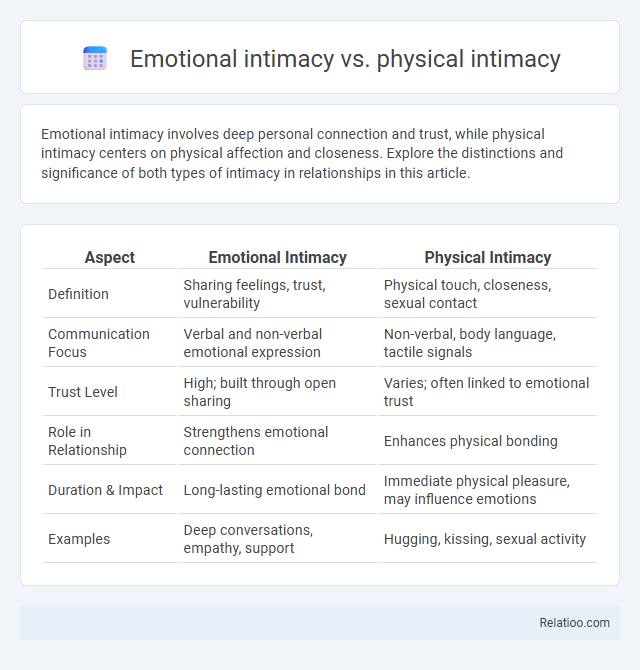Emotional intimacy involves deep personal connection and trust, while physical intimacy centers on physical affection and closeness. Explore the distinctions and significance of both types of intimacy in relationships in this article.
Table of Comparison
| Aspect | Emotional Intimacy | Physical Intimacy |
|---|---|---|
| Definition | Sharing feelings, trust, vulnerability | Physical touch, closeness, sexual contact |
| Communication Focus | Verbal and non-verbal emotional expression | Non-verbal, body language, tactile signals |
| Trust Level | High; built through open sharing | Varies; often linked to emotional trust |
| Role in Relationship | Strengthens emotional connection | Enhances physical bonding |
| Duration & Impact | Long-lasting emotional bond | Immediate physical pleasure, may influence emotions |
| Examples | Deep conversations, empathy, support | Hugging, kissing, sexual activity |
Understanding Emotional Intimacy
Emotional intimacy involves a deep connection built on trust, vulnerability, and open communication, allowing you to share your innermost feelings and thoughts without fear of judgment. Unlike physical intimacy, which centers on bodily closeness and touch, emotional intimacy fosters a strong psychological bond that strengthens relationships beyond physical interactions. Understanding emotional intimacy is crucial for nurturing meaningful connections that provide lasting support and security.
Defining Physical Intimacy
Physical intimacy involves close bodily contact such as hugging, kissing, or sexual activity, playing a crucial role in expressing affection and strengthening bonds. Emotional intimacy centers on sharing personal thoughts, feelings, and vulnerabilities, fostering deep connection and trust between partners. Understanding the distinction helps you nurture a balanced relationship where both physical closeness and emotional openness are valued.
Key Differences Between Emotional and Physical Intimacy
Emotional intimacy involves sharing personal feelings, thoughts, and vulnerabilities that foster deep connection and trust between partners, while physical intimacy centers on tactile expressions like hugging, kissing, and sexual activity that affirm affection and desire. Emotional intimacy builds attachment and understanding, influencing relationship satisfaction beyond physical contact, whereas physical intimacy primarily strengthens bonds through sensory experiences and hormonal responses. Both forms of intimacy are essential but serve distinct roles: emotional intimacy ensures long-term psychological connection, and physical intimacy enhances bodily closeness and immediate relational gratification.
The Role of Communication in Emotional Intimacy
Effective communication forms the foundation of emotional intimacy by enabling partners to share feelings, thoughts, and vulnerabilities openly. Unlike physical intimacy, which relies on bodily connection, emotional intimacy deepens relationship bonds through trust and mutual understanding fostered by honest dialogue. Enhanced communication skills contribute to stronger emotional connections, making intimacy more meaningful and resilient over time.
Physical Touch and Its Impact on Relationships
Physical touch plays a crucial role in fostering intimacy, directly influencing emotional closeness and connection between partners. Your ability to express affection through hugs, hand-holding, or gentle touches releases oxytocin, a hormone that reduces stress and strengthens bonding. Prioritizing physical intimacy enhances relationship satisfaction by creating a foundation of trust, comfort, and mutual understanding beyond verbal communication.
Building Trust Through Emotional Connection
Emotional intimacy, characterized by open communication and vulnerability, forms the foundation for building trust through genuine emotional connection. Physical intimacy enhances closeness but relies on the strength of emotional bonds for lasting trust and security. Your ability to cultivate emotional intimacy directly influences the depth of trust and overall intimacy in any relationship.
How Physical Intimacy Influences Emotional Bonds
Physical intimacy plays a crucial role in strengthening emotional bonds by releasing oxytocin, the hormone associated with attachment and trust, during close contact such as hugging, kissing, or cuddling. This biological response enhances feelings of safety and connection, facilitating deeper emotional intimacy between partners. Consequently, consistent physical closeness can lead to improved relationship satisfaction and stronger emotional ties.
Signs of a Lack of Emotional Intimacy
A lack of emotional intimacy often manifests through feelings of isolation, poor communication, and a decreased sense of trust and vulnerability between partners. Couples experiencing emotional disconnection may show minimal sharing of personal thoughts, reduced empathy, and avoid discussing deeper emotions, distinguishing it from physical intimacy that centers on touch and affection. Recognizing these signs early can help improve overall intimacy, fostering stronger relational bonds and emotional connection essential for lasting partnerships.
Balancing Emotional and Physical Intimacy
Balancing emotional and physical intimacy involves nurturing open communication, trust, and vulnerability alongside physical closeness, fostering a holistic connection in relationships. Emotional intimacy builds a foundation of understanding and empathy, which enhances the depth and satisfaction of physical intimacy. Prioritizing both forms ensures a mutually fulfilling partnership, where emotional bonds complement physical affection for lasting relational harmony.
Strengthening Both Forms of Intimacy in Relationships
Emotional intimacy involves sharing feelings, thoughts, and vulnerabilities that build trust and deepen connections, while physical intimacy includes affectionate touch and sexual closeness that foster bonding and comfort. Strengthening both forms of intimacy requires open communication, consistent emotional support, and mutual respect for boundaries to create a balanced and satisfying relationship. Prioritizing Your partner's emotional needs alongside physical closeness enhances overall intimacy and promotes long-lasting relationship fulfillment.

Infographic: Emotional intimacy vs Physical intimacy
 relatioo.com
relatioo.com